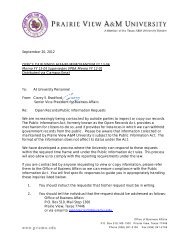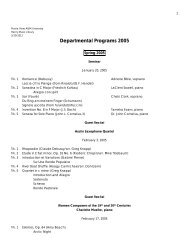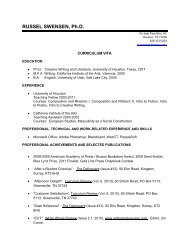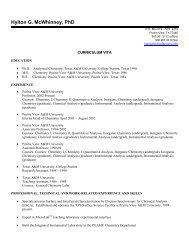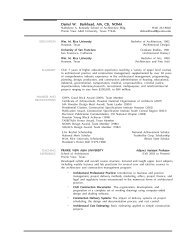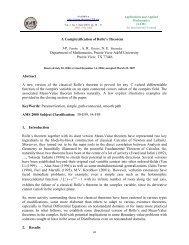Some applications of Dirac's delta function in Statistics for more than ...
Some applications of Dirac's delta function in Statistics for more than ...
Some applications of Dirac's delta function in Statistics for more than ...
You also want an ePaper? Increase the reach of your titles
YUMPU automatically turns print PDFs into web optimized ePapers that Google loves.
46 Santanu Chakraborty<br />
We can also consider conditional probabilities and th<strong>in</strong>k <strong>of</strong> express<strong>in</strong>g them <strong>in</strong> terms <strong>of</strong> the δ -<br />
<strong>function</strong>. Let us go back to the example <strong>of</strong> the two discrete random variables X and Y , where<br />
X takes the values m a a a , , , 1 2 and Y takes the values n b b b , , , 1 2 . Then, the conditional<br />
probability <strong>of</strong> Y = y given X = x is given by<br />
PY ( = y, X= x)<br />
p( y| x) = PY ( = y| X= x)<br />
=<br />
PX ( = x)<br />
∑∑<br />
pijδ( x−ai) δ( y−bj) pxy ( , ) 1≤≤ i m1≤j≤n = =<br />
.<br />
px ( ) pδ( x−a) ∑<br />
1≤≤<br />
i n<br />
i i<br />
5. Densities <strong>of</strong> Trans<strong>for</strong>mations <strong>of</strong> Random Variables Us<strong>in</strong>g δ -<strong>function</strong><br />
If X is a cont<strong>in</strong>uous random variable with a density <strong>function</strong> f (x)<br />
and if Y = g(X<br />
) is a<br />
<strong>function</strong> <strong>of</strong> X , then the density <strong>function</strong> <strong>of</strong> Y , namely, h (y)<br />
is given by<br />
∞<br />
∫<br />
−∞<br />
h ( y)<br />
= f ( x)<br />
δ ( y − g(<br />
x))<br />
dx .<br />
We can extend this to the two-dimensional case. If X and Y are two cont<strong>in</strong>uous random<br />
variables with jo<strong>in</strong>t density <strong>function</strong> f ( x,<br />
y)<br />
and if Z = φ1(<br />
X , Y ) and W = φ2<br />
( X , Y ) are two<br />
random variables obta<strong>in</strong>ed as trans<strong>for</strong>mations from ( X , Y ) , then the bivariate density <strong>function</strong><br />
<strong>for</strong> Z and W is given by<br />
∞ ∞<br />
( z,<br />
w)<br />
∫ ∫ f ( x,<br />
y)<br />
−∞−∞<br />
( z −φ1<br />
( x,<br />
y))<br />
δ ( w −φ<br />
2<br />
h = δ ( x,<br />
y))<br />
dxdy ,<br />
where z and w are the variables correspond<strong>in</strong>g to the trans<strong>for</strong>mations φ1( X , Y ) and φ 2 ( X , Y ) .<br />
This has obvious extension to the general p-dimensional case.<br />
Khuri (2004) gave an example <strong>of</strong> two <strong>in</strong>dependent Gamma random variables X and Y so that<br />
X and Y are gamma random variables with distributions Γ ( λ,<br />
α1)<br />
and Γ ( λ,<br />
α 2 ) respectively. If<br />
we denote the densities as f 1 and f 2 respectively, then we have,<br />
α1<br />
λ α1−1<br />
−λx<br />
f1(<br />
x)<br />
= x e , <strong>for</strong> x > 0<br />
Γ(<br />
α )<br />
1<br />
= 0 , <strong>for</strong> x ≤ 0 .




